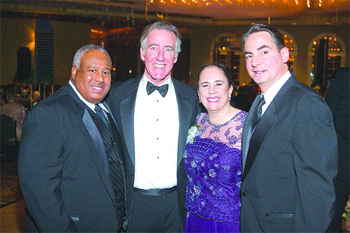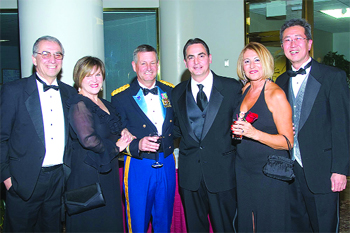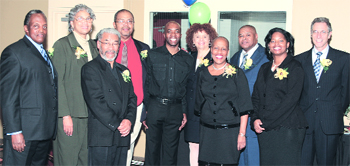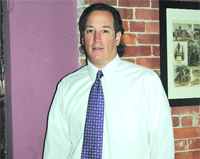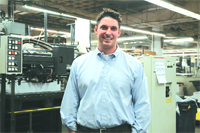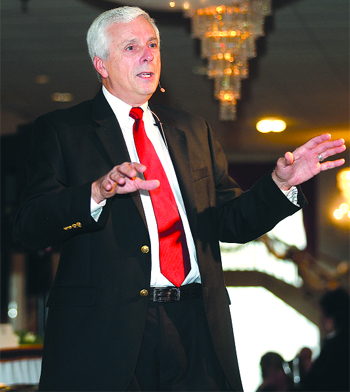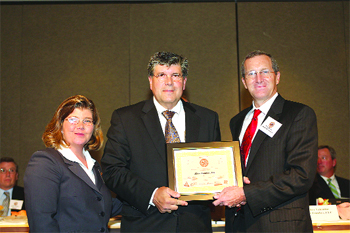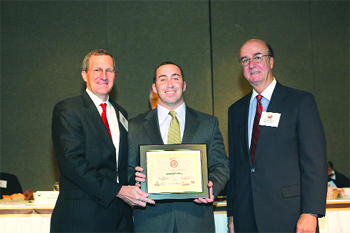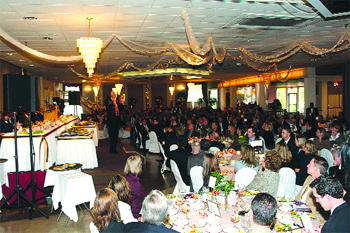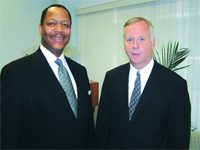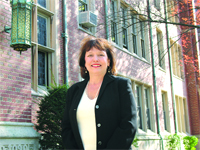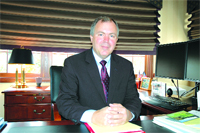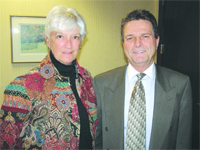The horse and buggy out by the curb have stood the test of time, although not without incident (‘Dobbin,’ as he’s called, has been ‘kidnapped’ and returned several times). He is a fixture in Holyoke, as is the landmark he’s associated with, the Yankee Pedlar Inn. Now marking its 60th year in business, the ‘Pedlar,’ as it’s called, blends history with fine food; tradition with a setting often described as unique.
The Yankee Pedlar Inn turned 60 a few months ago.
Six decades of uninterrupted business is quite a feat in the restaurant/banquet sector, but there haven’t been any real celebrations to mark the occasion, said Kim Clayton-McGrath. She’s sales manager at the ‘Pedlar,’ as it’s called, and daughter of current owners Martin and Rosemary Clayton, who purchased the Holyoke landmark in 1995.
“We’ve just been plugging along day to day, working hard … it’s been that way for the past 60 years,” she said of the definite lack of fanfare with regards to the recent milestone, noting that this industry, which is always challenging, is even more so these days with the economy sagging and soaring gas prices keeping people home. “We’re focused on today and tomorrow.”
And besides, she told BusinessWest, the Pedlar celebrates its history and traditions every day, not on those round-number anniversaries, and it does so in a number of ways.
There are the pictures on the walls of the Holyoke Room — one of several smaller banquet rooms — showing the landmark in its many stages of its development. And one of the other rooms is named Simone’s in honor of a recently deceased employee, Simone Patenaude, who worked there “forever,” said Clayton-McGrath.
There’s also the picture of the Pedlar’s first owners, Eugene and Catherine Tamburi, hanging in one of the hallways. Meanwhile, there’s a mural in the Tavern Bar & Grill, the main restaurant, that offers a time-altered view of life at the Pedlar; it includes personalities from the past (the Tamburis, Patenaude, and Johnny Marion, who played the piano there back in the ’50s and ’60s) sharing the room with some from the present, including the Claytons and waitresses, or “fixtures,” Sandy Mumblow and Carole Mazzu.
And then, there’s Dobbin, the stuffed horse attached to an antique carriage that has stood outside the Pedlar since 1953. Dobbin wasn’t in The Wizard of Oz, but he’s been a horse of many different colors. Now white, he’s been black and also spotted. He was painted green, gold, and white (by parties unknown) for one recent St. Patrick’s Day week (the route for the city’s famous parade winds past the landmark), and has also been hot pink for one recent holiday season.
“Who knows how many different colors you’d see if you scraped all that paint off,” said Clayton-McGrath, adding that the equine’s tail was recently stolen and replaced, for the umpteenth time. “He’s been kidnapped I don’t know how many times, but always returned to us; that horse is a legend around here.”
And like Dobbin, the Pedlar is a survivor, withstanding changes to Holyoke’s downtown and overall character; mounting competition, especially in Holyoke, where there are several banquet and meeting facilities; those higher gasoline prices; and several cycles of the economy. The facility owes its resilience to the fact that it is a landmark, said Clayton-McGrath, one to which individuals, families, businesses, and organizations have remained loyal for decades.
But it also has some features that make it stand out in a crowded marketplace. They include those smaller, and also unique, banquet rooms, something missing at most halls, she said, and also the Pedlar’s Opera House. Added by the Tamburis in 1973, the two-level room has been the site of theatrical performances, charity events, hundreds of weddings, and, until recently, a regular Sunday brunch.
That tradition was halted on the basis of pure economics, said Clayton-McGrath, noting that for some time the weekly brunch was taking in less money than it cost to put it on.
The demise of the brunch — there is some talk of reviving it — is a reminder that businesses, even those as old and storied as the Pedlar, have to balance tradition with good business sense. The ability to do this has given the landmark both a rich past and strong prospects for the future.
Talking Turkey
Clayton-McGrath sat down with BusinessWest just a few days before Thanksgiving.
This is always a busy time at the Pedlar. More than 1,000 people traditionally come through the doors for the holiday buffet, she explained, and there are always a number of gatherings of all sizes, including several high school reunions, scheduled through the long weekend.
Having all those activities go off as planned requires large doses of preparation and attention to detail, she said, noting that the staff at the Pedlar have had plenty of practice. Many of the employees have been with the establishment for years, if not decades. They’ve seen times change, but not the Pedlar’s blend of atmosphere and tradition.
It all started on June 7, 1947, roughly a year after the Tamburis purchased what had long been the home of Judge John Hildredth, who left England in 1871 to settle in Holyoke. The home, situated at the junction of roads known now as Routes 5 and 202, was built in 1875, and its size and location made it ideal for an inn.
Over the years, however, the restaurant, which seated only 25 when the Pedlar first opened, became increasingly popular, requiring the Tamburis and subsequent owners to devote ever-larger amounts of square footage to dining and banquet facilities. Today, only a few of the original guest rooms remain, and they are used as bridal suites.
Those rooms are put to great use, because the Pedlar has long been a very popular site for weddings, said Clayton-McGrath, and the Opera House has much to do with this phenomenon. “A bride feels like a princess in this room,” she said while decending from the Opera House’s balcony. “You can get some incredible pictures in here.”
Capable of seating more than 200, the room features a chandelier from the former New York Metropolitan Opera House, which was torn down in 1963, and a large wooden bar rescued from Kenilworth Castle. This was Holyoke’s version of the famed English castle, a brick-and-stone mansion that was home to E.C. Taft, one of the city’s many prominent mill owners, and torn down in 1959. Many artifacts from the castle, as well as pictures of it, dominate another of the smaller dining areas known as the Kenilworth Room.
In 1977, the Yankee Pedlar was purchased by the Banks, Frank and Claire, who put their own stamp on the facility through nearly two decades of ownership. They added the Garden Room, another popular site for weddings, those of the smaller variety; the Herb Terrace; and Simone’s, a small, French bistro-style restaurant inspired by a trip to Europe.
The Clayton family, which had been in Holyoke for three generations and owned the Martin J. Clayton Insurance Agency, located just down the street from the Pedlar, purchased the landmark in 1995. A year later, they remodeled the former sandwich and pub area known as the Oyster Bar and renamed it the Tavern Bar & Grill.
Food for Thought
How Clayton-McGrath, a former paralegal, came to be sales manager for her parents’ business venture is largely a matter of circumstance. She and her husband, Neil McGrath, a football coach by trade, were living in Maine (he was coaching at the state university), when the Pedlar was acquired. When Neil took a job at UMass in the mid-’90s, the couple relocated to Holyoke, and Clayton-McGrath accepted an invitation to help manage the city landmark.
She started with mother’s hours, but eventually made this a full-time exploit, something she believes her father had in mind from the beginning.
These days, Clayton-McGrath and other members of a management team that includes “Master” Chef Ed Klinger, Banquet Manager Nancy Wheeler, HR Director Abby Leroux, and Martin Clayton (now semi-retired and living in Florida) are leading the Pedlar through a time of change and challenge.
While the restaurant side of the business remains fairly steady, there are simply fewer people going to dinner, lunch, and, yes, brunch, these days, said Clayton-McGrath. There are several reasons for this, including time constraints on business people, a smaller business community in Holyoke, the general economy, and even gas prices.
“When gas hits $3 a gallon, a lot of people just don’t want to move out of their driveways,” she said, noting that she’s seen a drop in business since the most recent climb to that price threshold. “Just about everything affects this business; when people have less money to spend, they just don’t go out to eat as much.”
All this has contributed to a greater emphasis on the banquet and special-event side of the ledger, which, while it’s not recession or gas price-proof, continues to thrive at the Pedlar, despite mounting competition.
This success is due to a blend of flexibility, tradition, a diverse and reasonably priced menu, and strong customer service, she explained, noting that the Pedlar has eight banquet rooms of various sizes, many of which can accommodate groups of 20 or fewer, which helps the landmark stand out.
“The smaller parties add up,” she explained. “And people are very grateful when they can find a small room; we hear so many people say, ‘we can’t get anything anywhere for a party of 20; no one will take us.’”
As she offered a tour of the Pedlar, Clayton-McGrath started in one of those smaller facilities, the Kenilworth Room. She pointed to a stained-glass window that is just one of many artifacts from the mansion.
From the Tavern and its famous mural, Clayton-McGrath proceeded to the Holyoke Room, complete with photos of the Pedlar taken over several decades, as well as pictures of other landmarks, including Mountain Park, its famous carousel, and City Hall.
Other venues include the Pedlar Club, used typically for cocktail and hors d’oeuvres receptions; the Loft, so named because it’s on the second floor; and the Oakdale.
This volume and variety of smaller rooms gives the Pedlar the flexibility to handle functions ranging from small bridal showers to anniversary parties; from bus tours (many originating in Connecticut or New Hampshire stop at the landmark on their way to or from Yankee Candle, the Holyoke Mall, and other tourist stops) to a host of holiday parties.
“We’re booking more Christmas parties than ever before,” said Clayton-McGrath, noting that the Pedlar can handle virtually any-sized get-together. “And we’re doing more in January every year — that’s because everybody’s really busy in December, and we’re all looking for something to do in January.”
And then, there’s the parade.
Planning for the colossal undertaking is essentially a year-round undertaking, she said, noting that the Pedlar plays host to many meetings and events. Parade week is an especially busy time, and for Clayton-McGrath and most others, work on the day of the parade starts well before the sun comes up and ends long after it’s gone down.
“It’s just crazy, crazy here,” she said of parade day, noting that people start setting up chairs outside the Pedlar at 7 a.m. “It’s fun morning, noon, and night — we have the workers’ breakfast at 6 and the after-parade dinner.”
Mane Event
Glancing out her office window in the direction of Dobbin and the ancient buggy, Clayton-McGrath said the latter is overdue for an overhaul.
“It’s very, very old wagon, and we’re constantly putting tape around it and telling people to stay off,” she said, adding that many try to sit in for the parade, and the Pedlar doesn’t want to see anyone hurt. “It needs some work.”
Though it’s weathered, the buggy has stood the test of time — as has the Pedlar. It’s done so through a blend of tradition and atmosphere and more than a little … well, let’s call it horse sense.
George O’Brien can be reached at[email protected]
